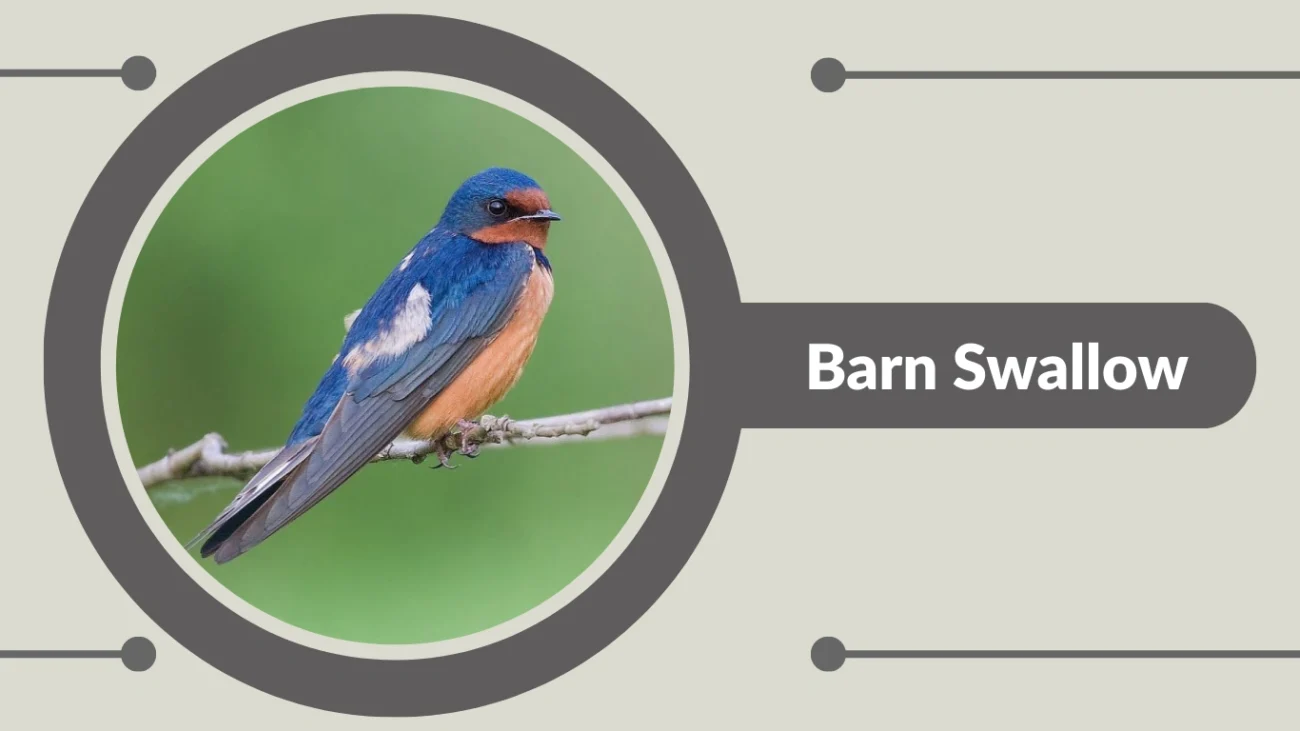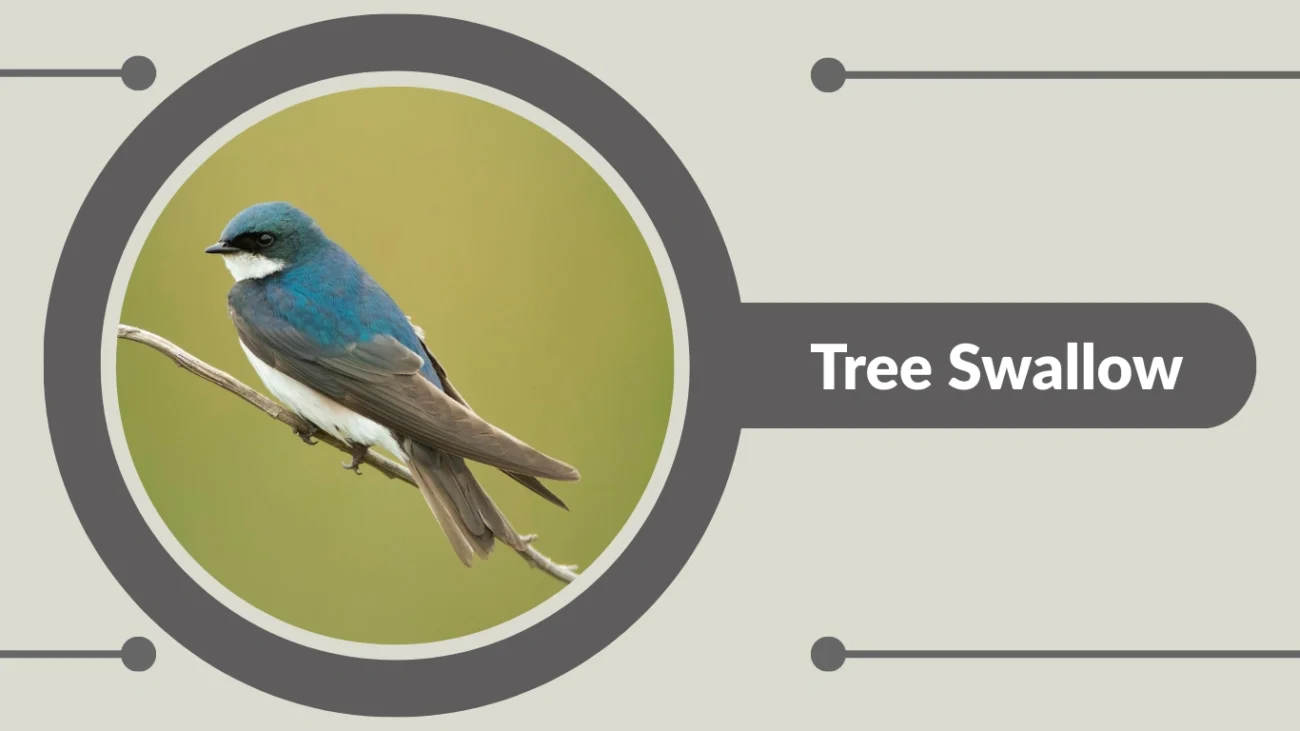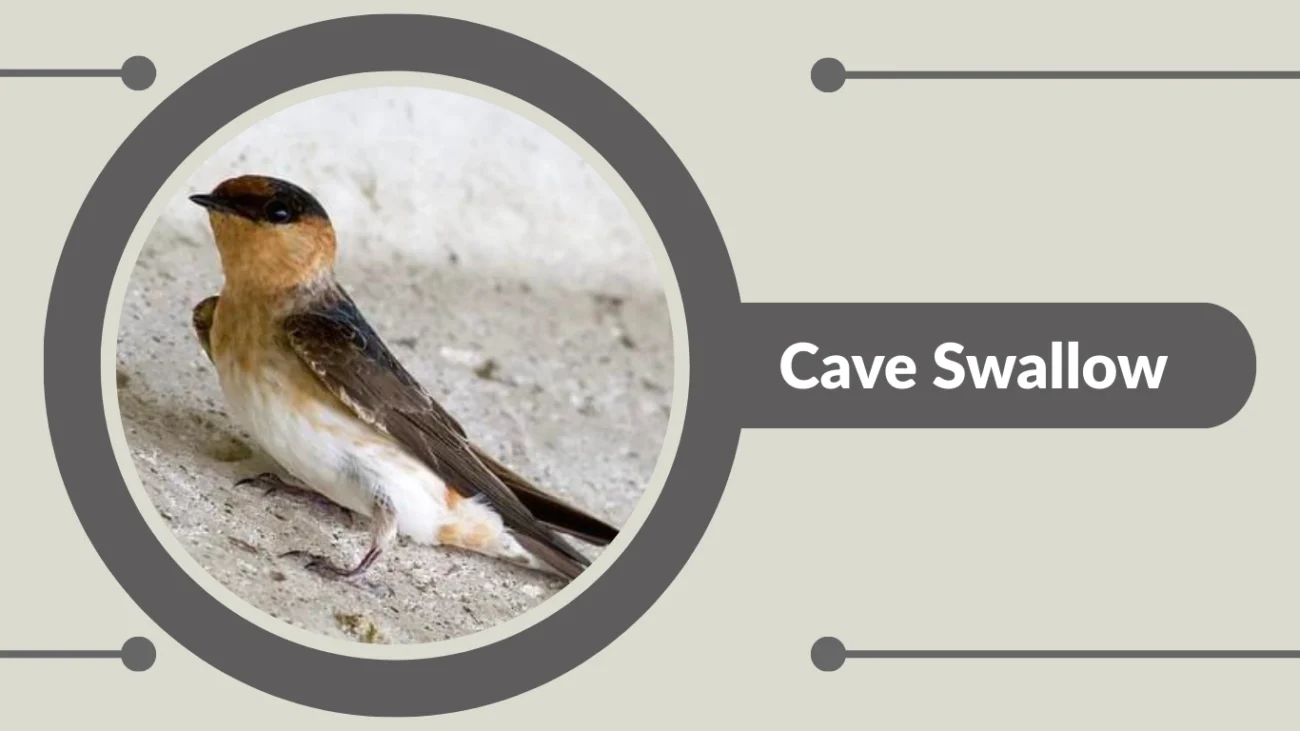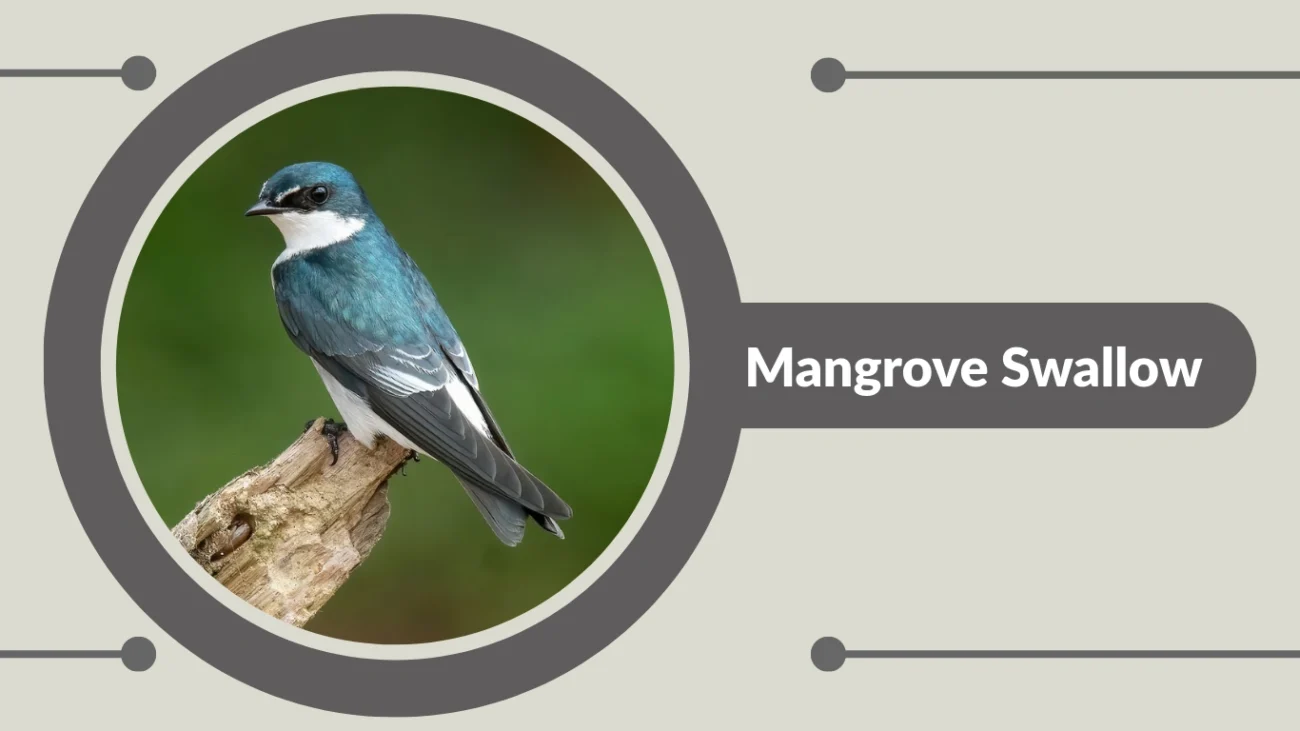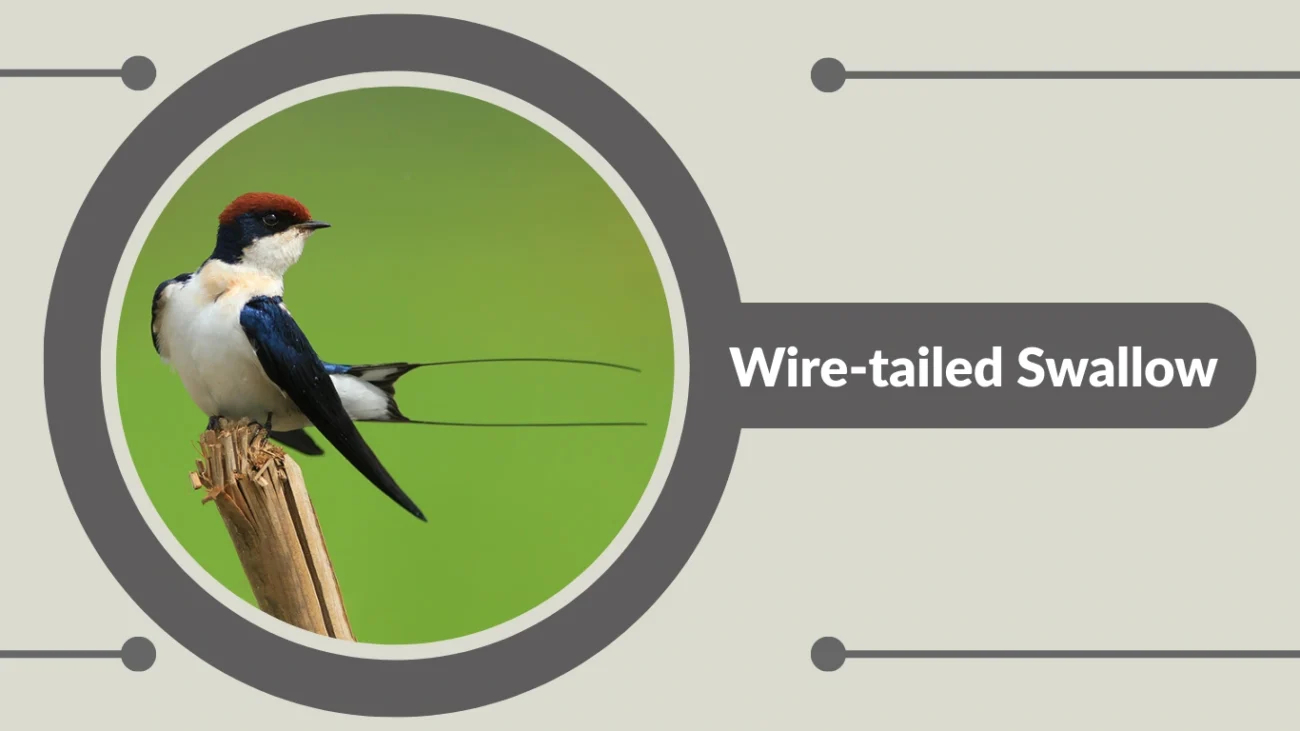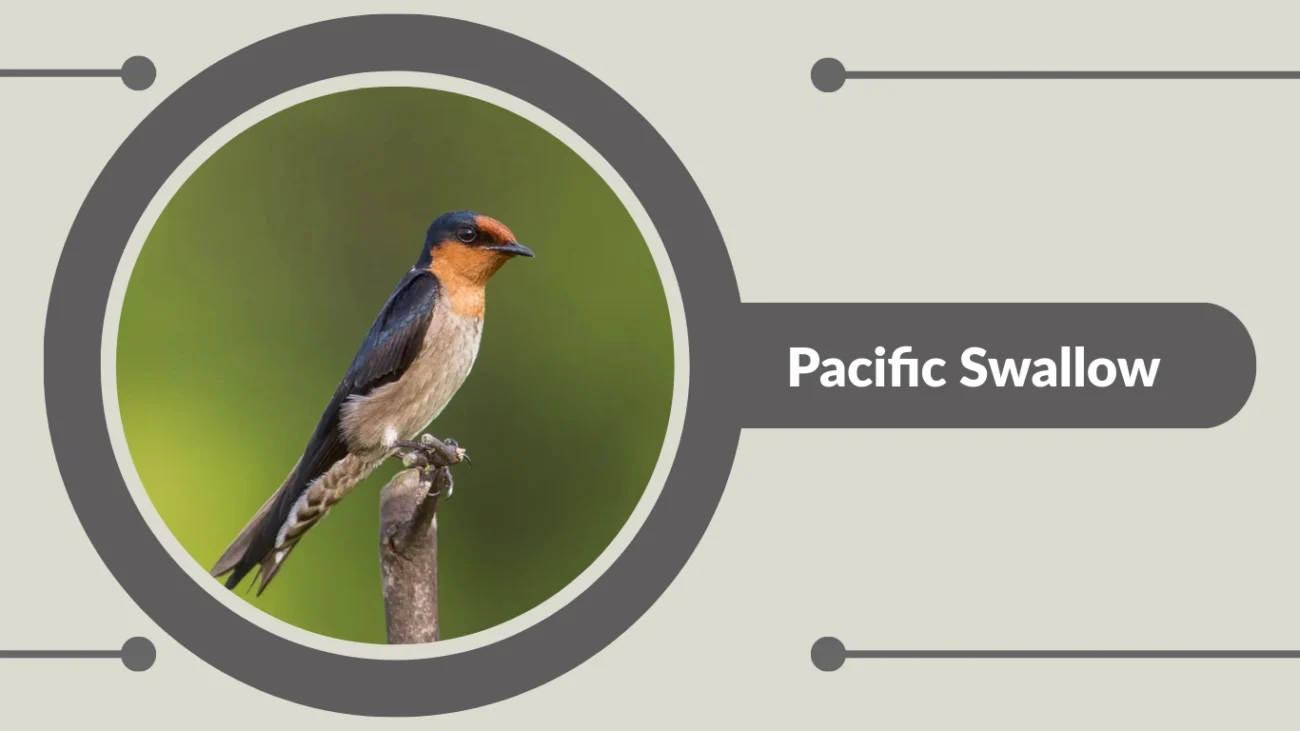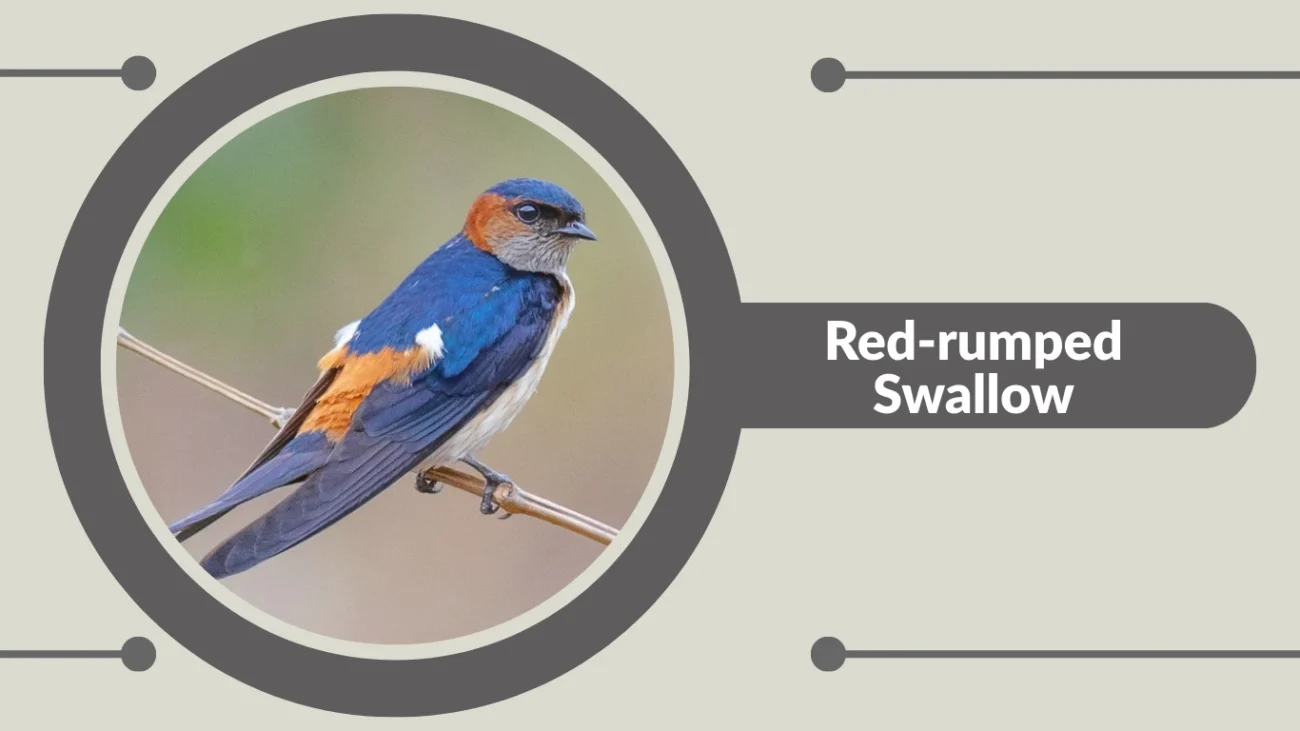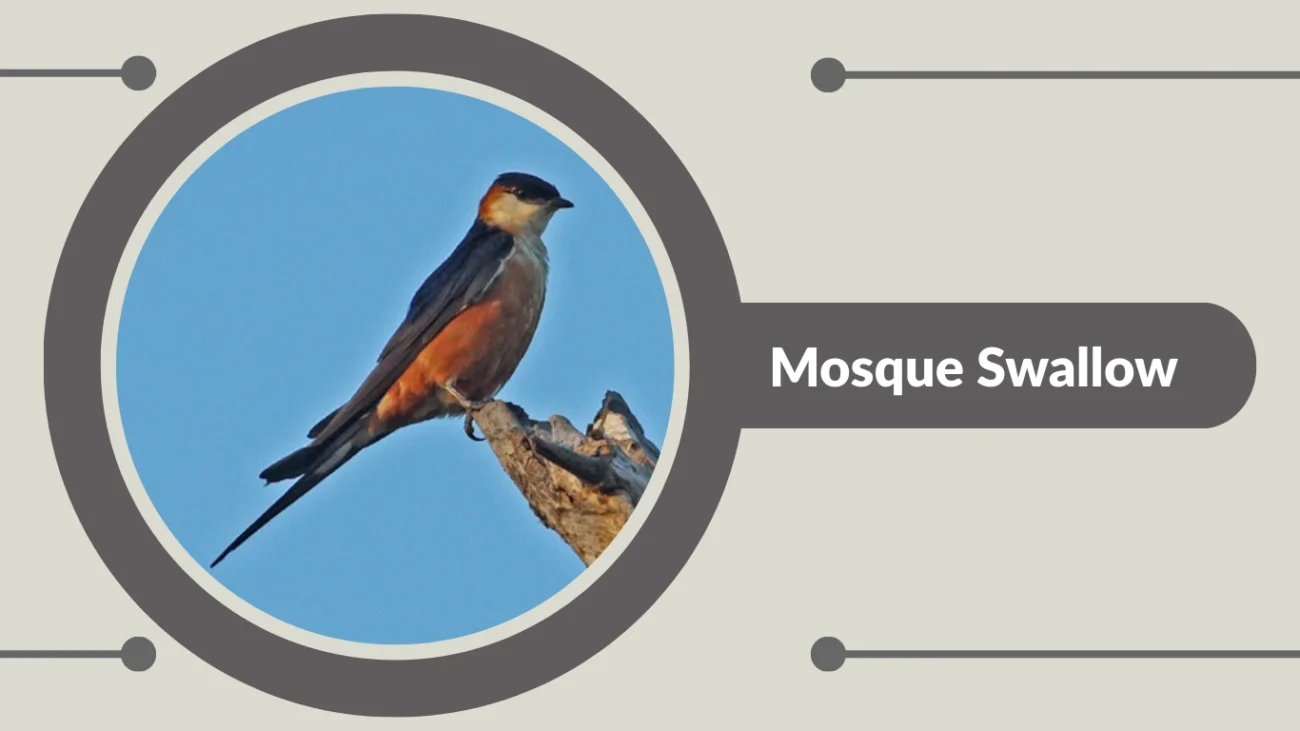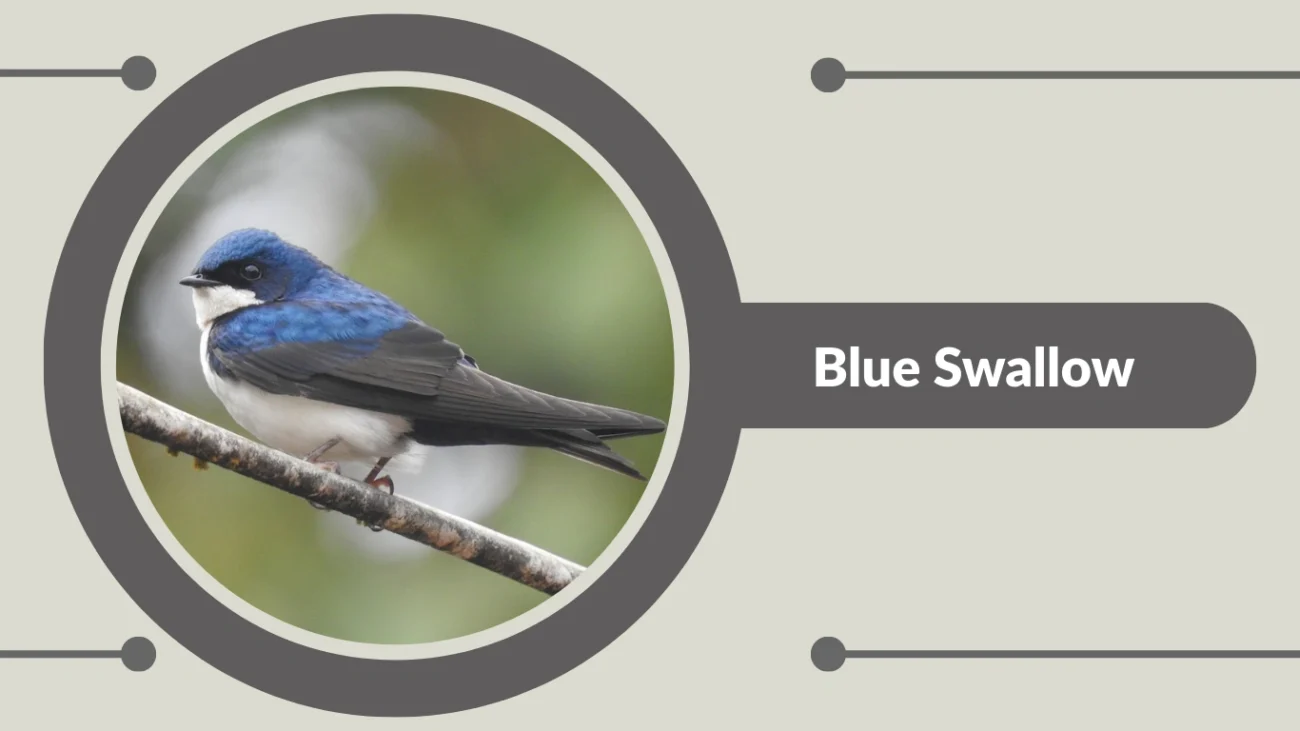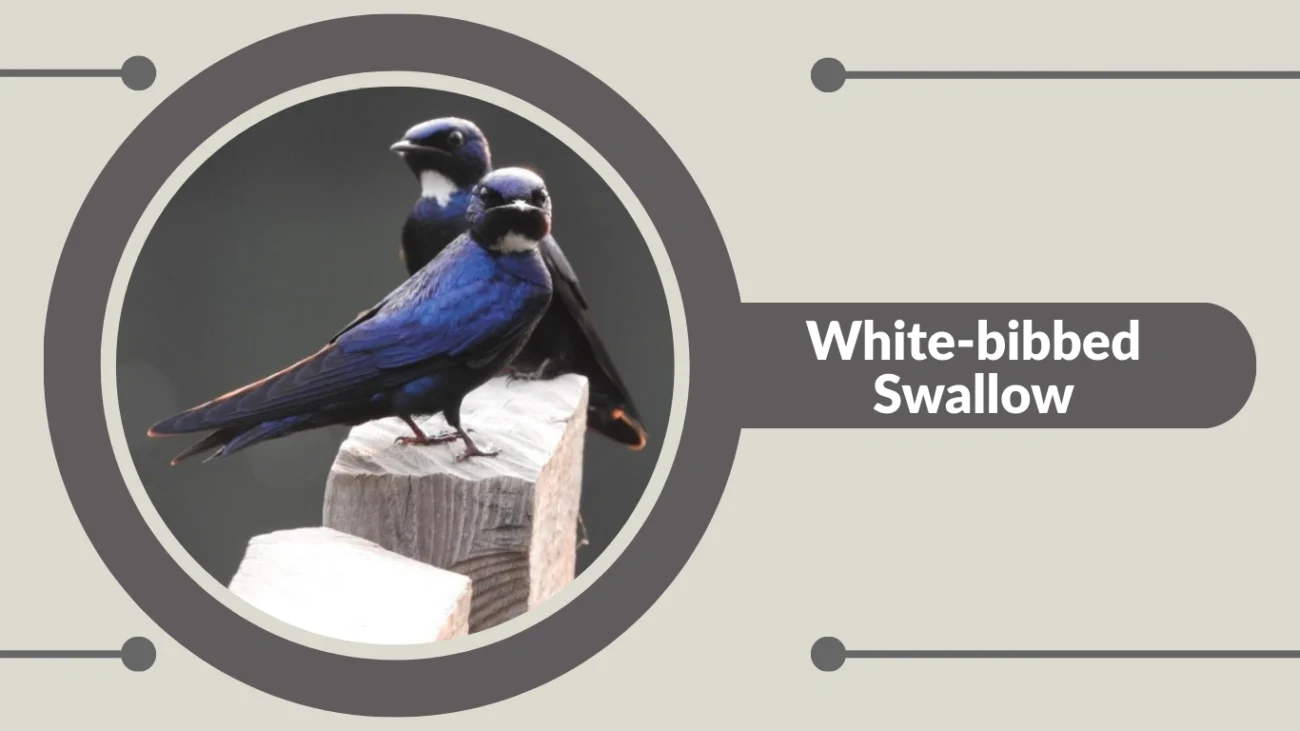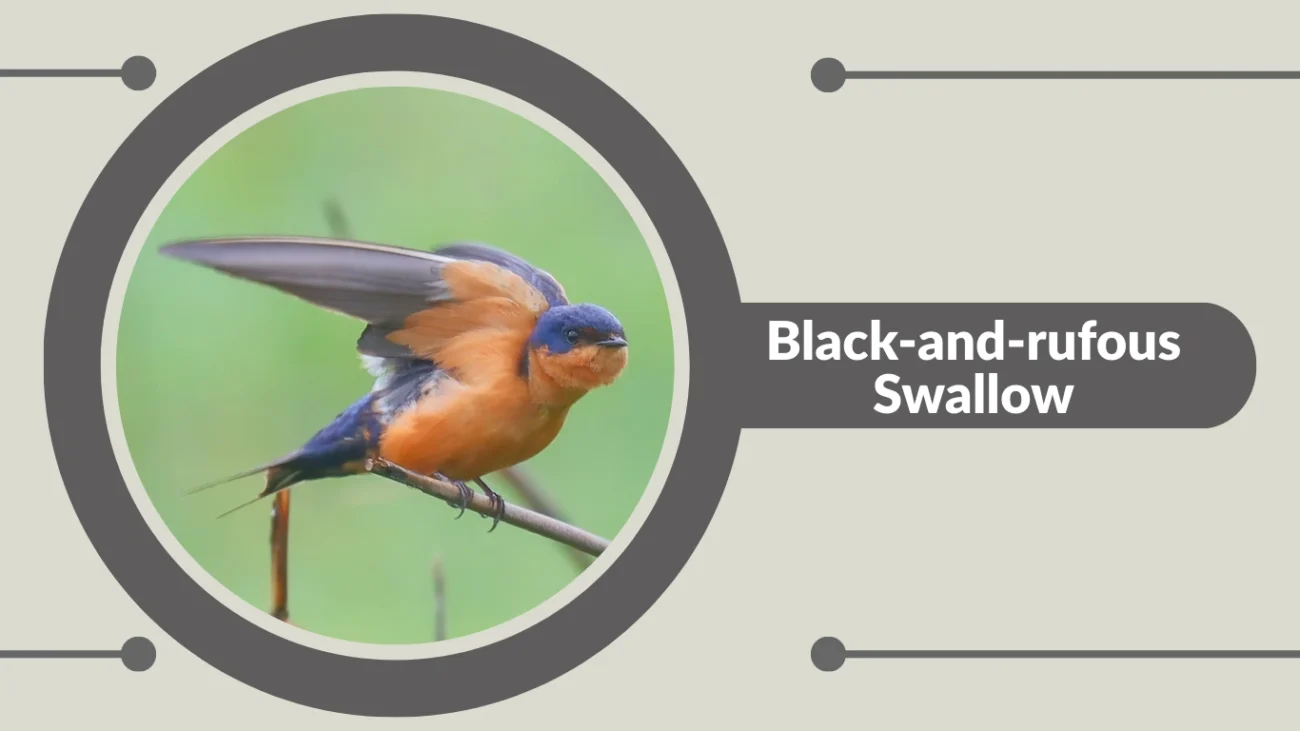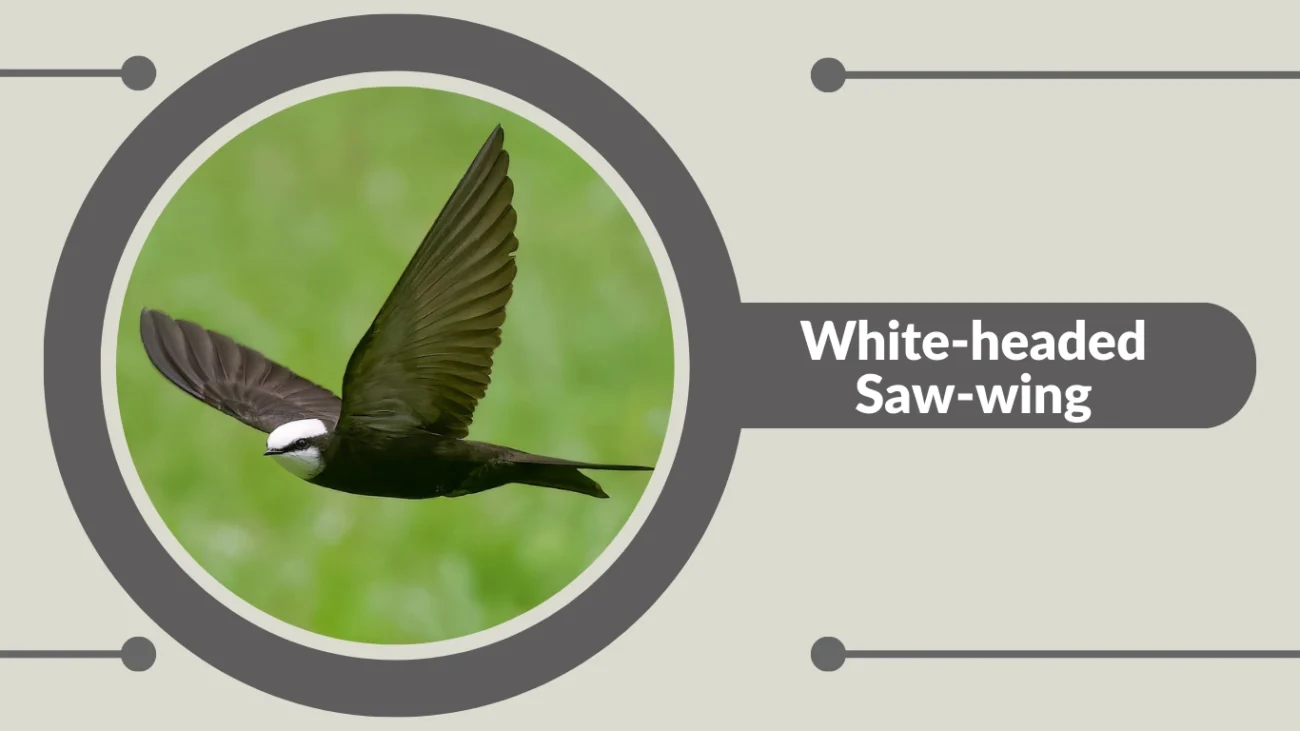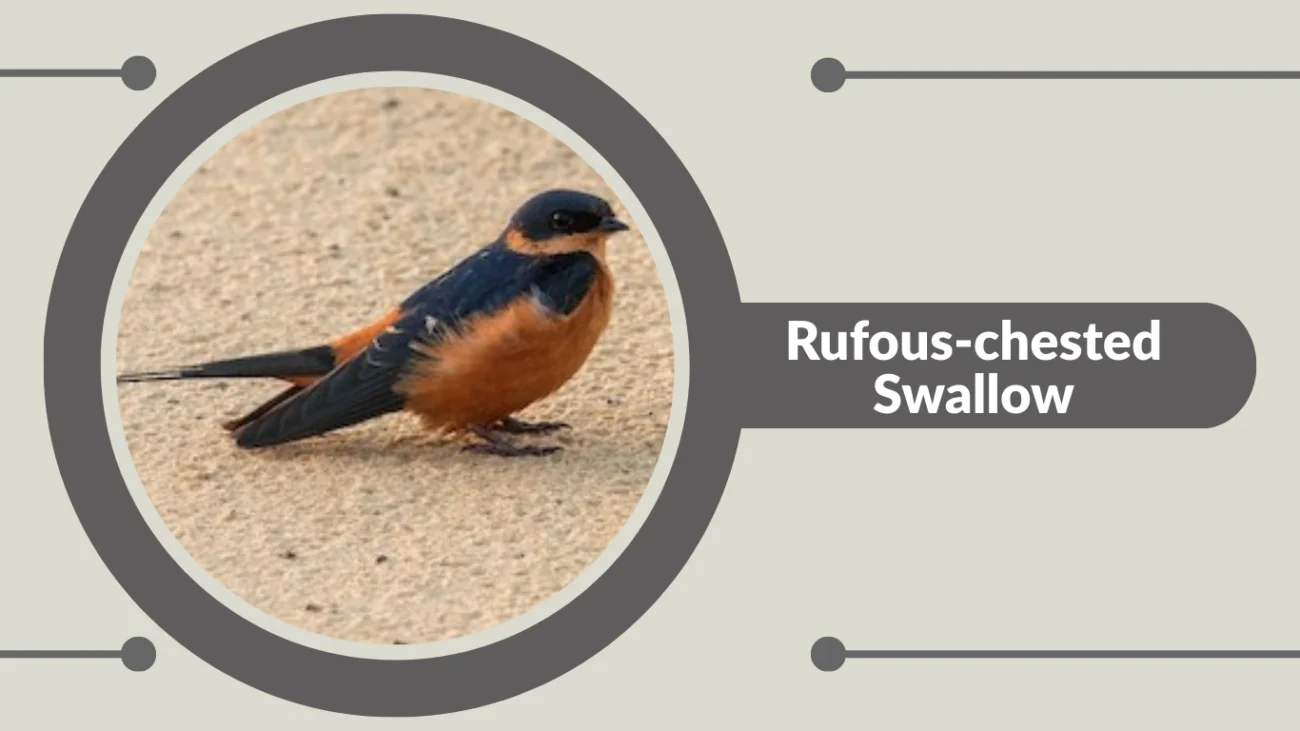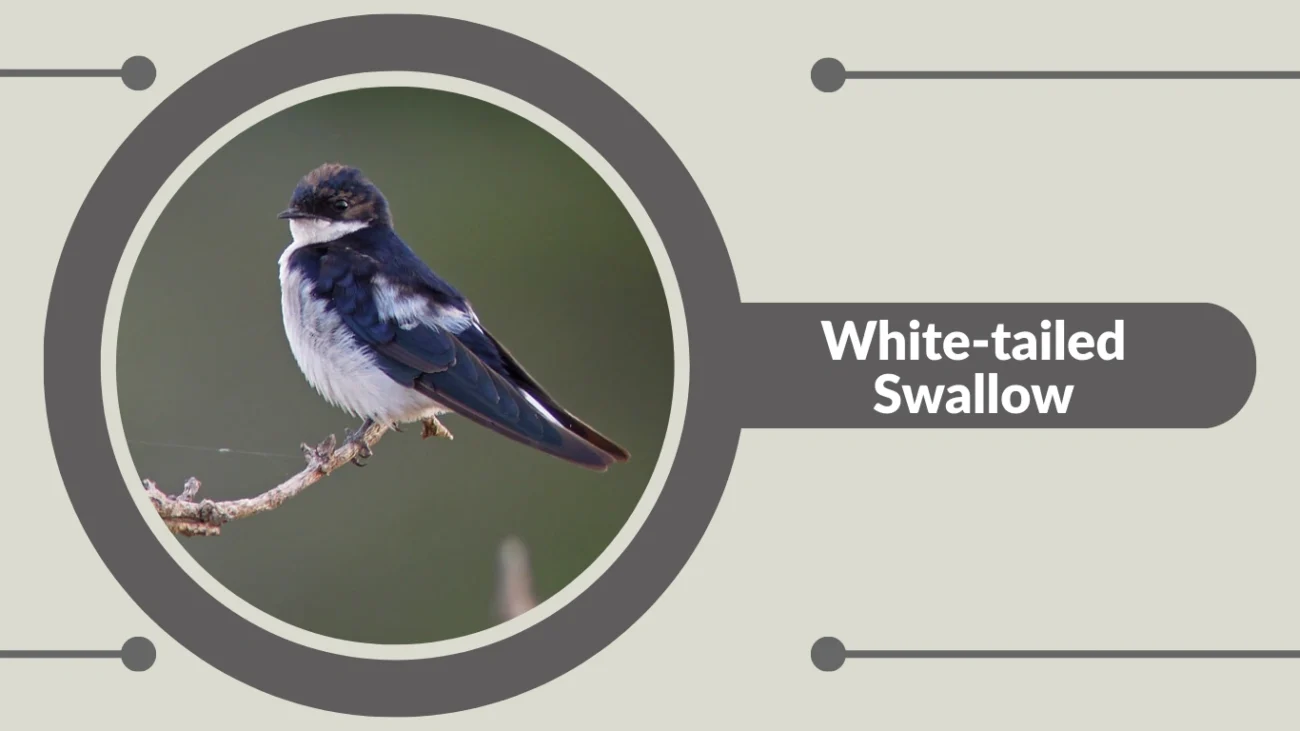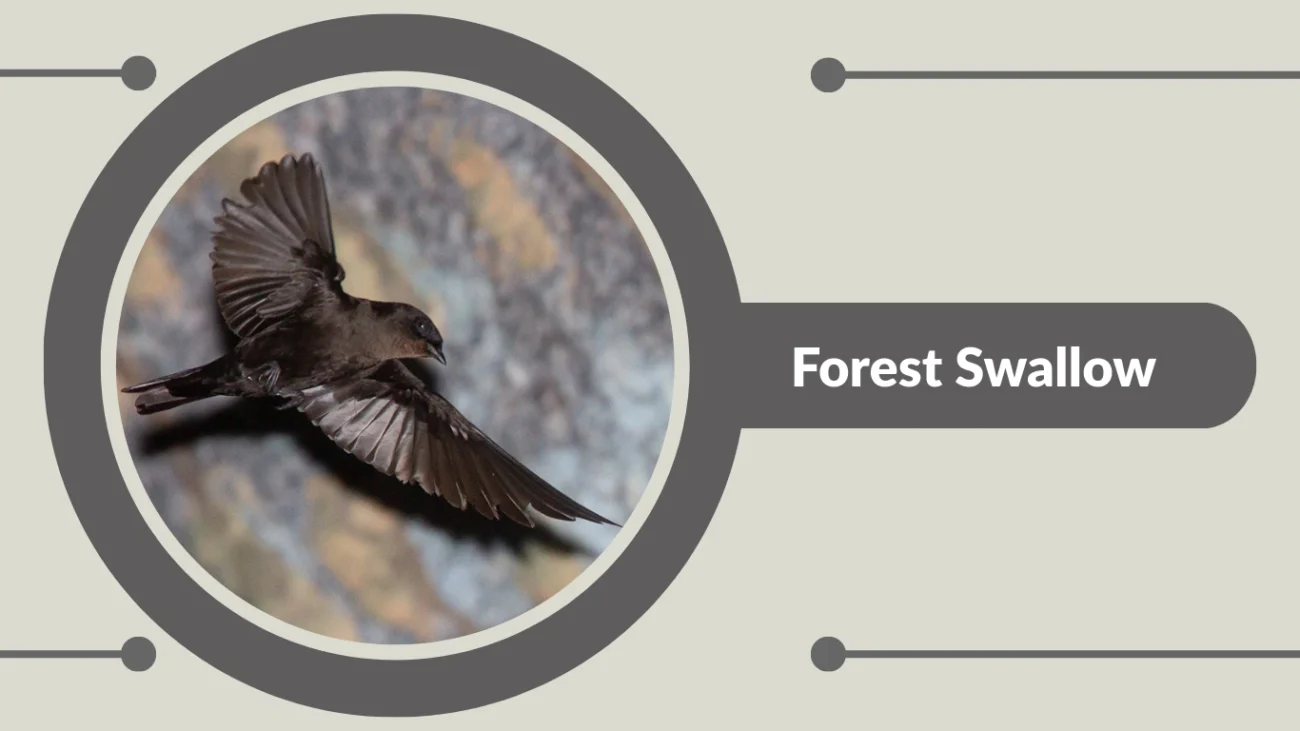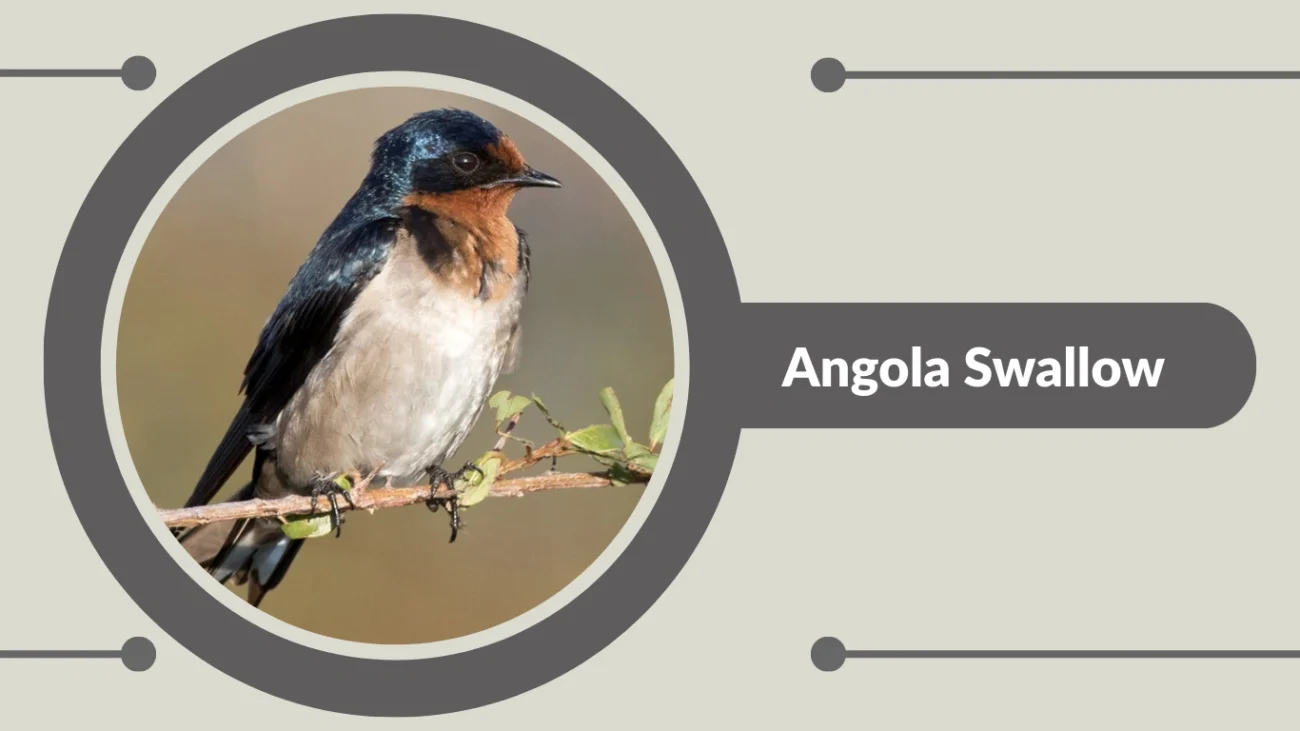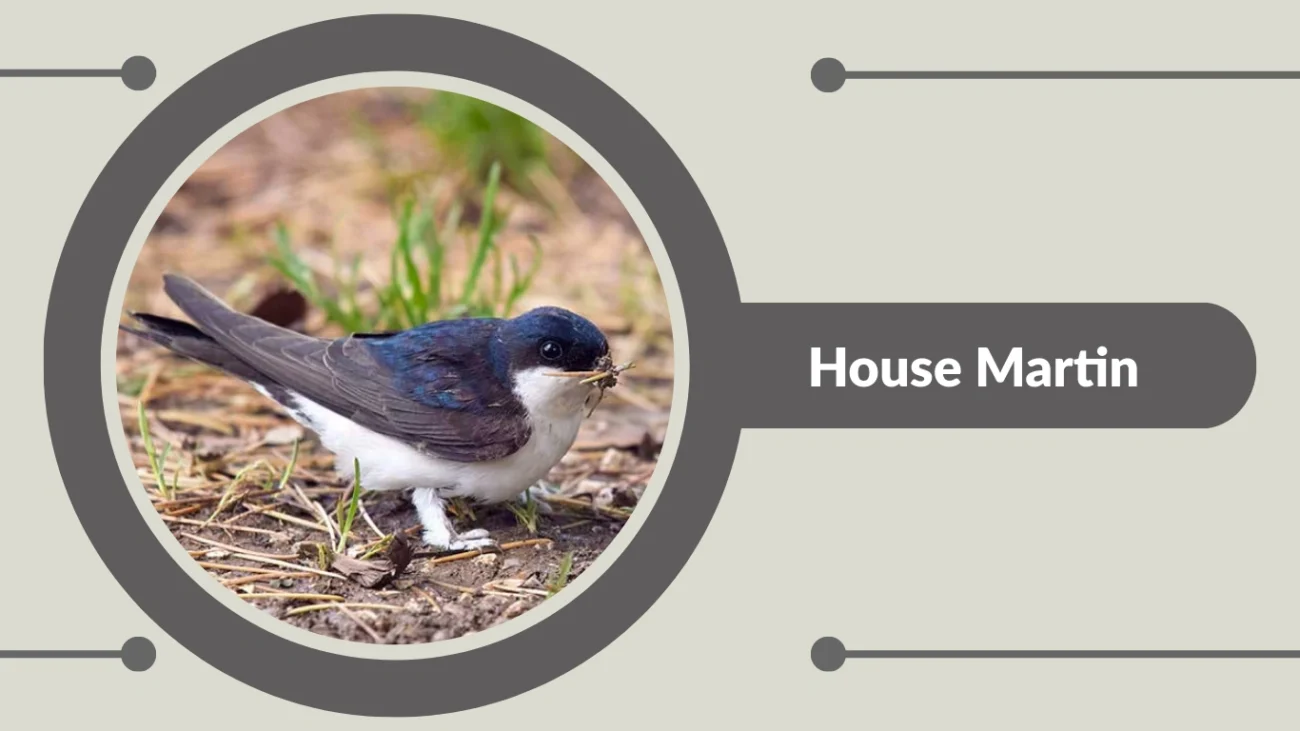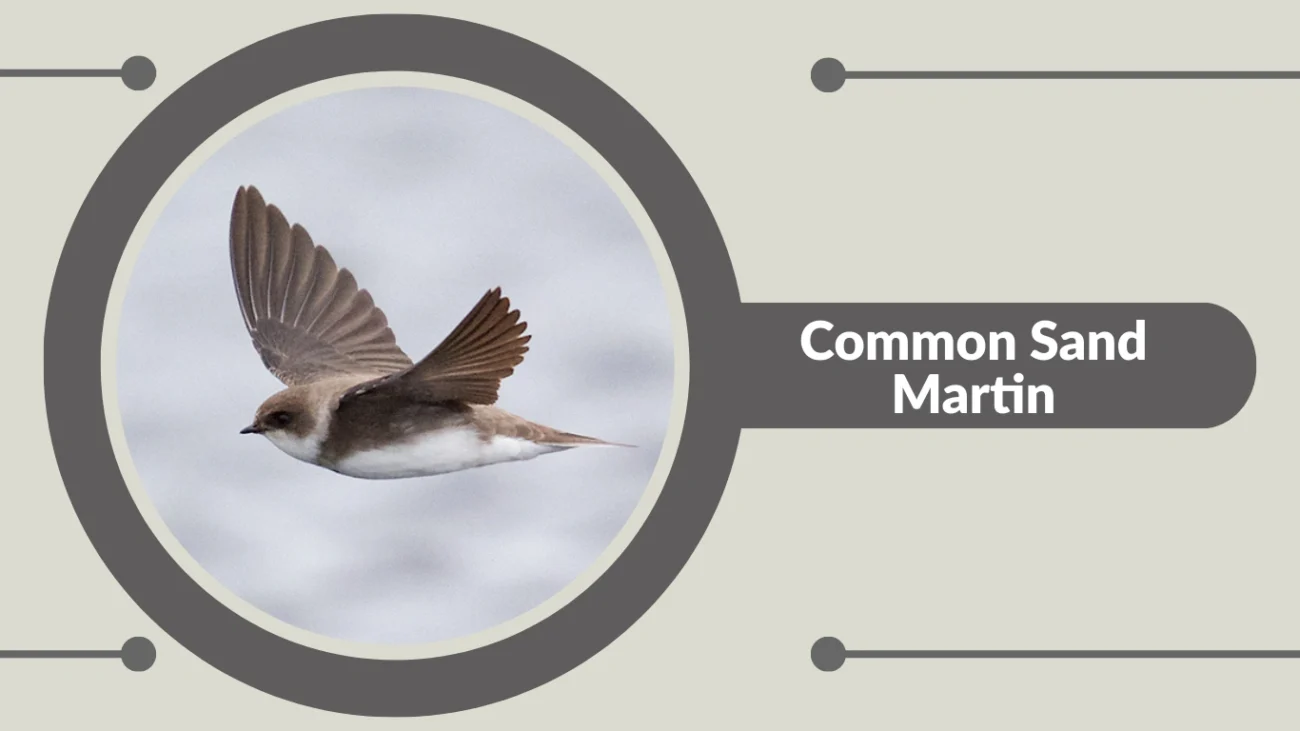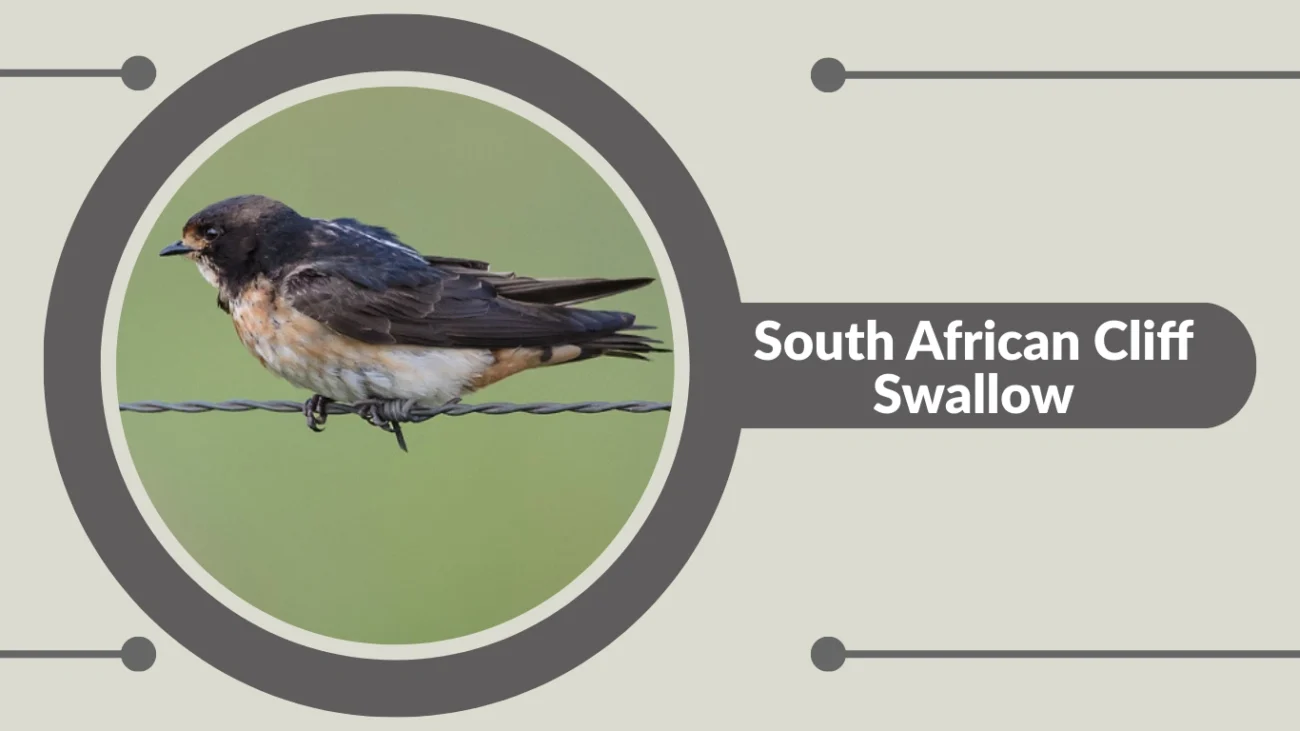Swallows are agile, insect-eating birds found in diverse habitats across the globe. Known for their graceful flight and distinctive plumage patterns, these birds often migrate long distances between breeding and wintering grounds. From the familiar barn swallow to rare species like the white-tailed swallow, each has unique traits, habitats, and nesting behaviors. This guide explores 27 swallow species, detailing their key identification features, habitats, and feeding habits.
1. Barn Swallow
The barn swallow (Hirundo rustica) is one of the most widespread and recognized swallow species in the world. Known for its graceful flight, deeply forked tail, and adaptability to human-made structures, it thrives in both rural and urban areas. Its migratory nature takes it across continents, making it a familiar sight during warmer months in many regions.
Identification
- Scientific Name: Hirundo rustica
- Body Size: About 15–20 cm in length
- Color: Glossy blue upperparts, reddish forehead and throat, creamy underparts
- Tail Shape: Deeply forked with long outer feathers
- Bill: Short and wide, adapted for catching insects in flight
Habitat and Distribution
Barn swallows prefer open areas such as farmlands, meadows, and near bodies of water. They often build mud nests under eaves, bridges, and inside barns. This species is found across North America, Europe, Asia, and parts of Africa, migrating to warmer regions during winter.
Behavior and Diet
They are agile fliers that catch insects mid-air, feeding on flies, beetles, moths, and other flying invertebrates. Barn swallows are social birds, often nesting in loose colonies and roosting together during migration.
2. Tree Swallow
The tree swallow (Tachycineta bicolor) is a sleek, agile songbird best known for its iridescent blue-green upperparts and pure white underside. It is a skilled aerial hunter, often seen darting gracefully over open water or fields in search of insects. This species is a seasonal migrant in many parts of its range, thriving in both natural and human-made nesting sites.
Identification
- Scientific Name: Tachycineta bicolor
- Body Size: About 12–15 cm in length
- Color: Iridescent blue-green upperparts, white underparts, and a short, slightly forked tail
- Bill: Short and black, perfect for catching flying insects
- Wings: Long and pointed, adapted for swift, acrobatic flight
Habitat and Distribution
Tree swallows are typically found near open areas with abundant flying insects, such as wetlands, lakeshores, fields, and meadows. They breed across North America, from Alaska to the southern United States, and migrate to Central America, the Caribbean, and northern South America during the winter months.
Behavior and Diet
They feed mainly on flying insects, including flies, beetles, and mosquitoes, which they capture in midair. In cooler seasons or when insects are scarce, tree swallows also consume berries, especially bayberries. They are cavity-nesters, often using old woodpecker holes or nest boxes provided by humans.
3. Bank Swallow
The bank swallow (Riparia riparia) is the smallest swallow species found in much of its range. It is easily recognized by its brown upperparts, white underside, and distinctive dark breast band. This species is highly social, nesting in large colonies along riverbanks and sandy cliffs. Its swift, fluttering flight helps it maneuver with precision while chasing insects in open air.
Identification
- Scientific Name: Riparia riparia
- Body Size: About 12–14 cm in length
- Color: Brown upperparts, white underparts, and a dark band across the chest
- Tail: Slightly forked
- Bill: Short and black, suited for catching small flying insects
Habitat and Distribution
Bank swallows prefer open areas near water, especially riverbanks, sandpits, coastal dunes, and lakeshores where they can dig nesting burrows. They breed across North America, Europe, and Asia, migrating to Central and South America, Africa, and southern Asia for the winter.
Behavior and Diet
They feed primarily on small flying insects, including mosquitoes, midges, and flies, often captured in swift aerial chases. Bank swallows are colonial nesters, excavating tunnels into sandy or soft soil banks where they lay their eggs in chambers at the tunnel ends.
4. Cliff Swallow
The cliff swallow (Petrochelidon pyrrhonota) is a highly social and adaptable species, well known for its gourd-shaped mud nests clustered under bridges, cliffs, and building eaves. With its square tail and pale, buffy rump, it is easy to distinguish from other swallows in flight. These birds form large colonies, sometimes numbering in the thousands, making them one of the most communal swallow species.
Identification
- Scientific Name: Petrochelidon pyrrhonota
- Body Size: About 13–15 cm in length
- Color: Dark blue upperparts, pale underparts, rusty throat, and buff-colored rump
- Tail: Short and squared, unlike the forked tails of many swallows
- Bill: Small and dark, adapted for catching insects on the wing
Habitat and Distribution
Cliff swallows inhabit open areas near water, cliffs, and human structures, favoring spots where mud is available for nest building. They are widely distributed across North America, breeding from Alaska to Mexico and wintering in South America.
Behavior and Diet
They feed mainly on flying insects, especially swarming species like mosquitoes and flies. Cliff swallows are skilled fliers, often foraging in large flocks. Their tightly packed nesting colonies provide protection from predators and allow for cooperative behaviors like mobbing threats.
5. Cave Swallow
The cave swallow (Petrochelidon fulva) is a colorful, medium-sized swallow often found in colonies inside caves, under bridges, and in culverts. Recognized by its pale forehead, rusty throat, and squared tail, this species shares some nesting habits with the cliff swallow but favors more sheltered environments.
Identification
- Scientific Name: Petrochelidon fulva
- Body Size: About 13–15 cm in length
- Color: Dark blue upperparts, cinnamon rump and forehead, pale underparts, and rusty throat
- Tail: Short and squared, similar to cliff swallows
- Bill: Short, black, and adapted for snatching insects from the air
Habitat and Distribution
Naturally found in limestone caves, they have adapted to using man-made structures such as highway underpasses and tunnels. Cave swallows breed in the southern United States, Mexico, Central America, and parts of the Caribbean, with some populations migrating to South America for the winter.
Behavior and Diet
They feed primarily on flying insects, including flies, beetles, and wasps, captured in fast, agile flight. Cave swallows are colonial nesters, often building their gourd-shaped mud nests in clusters that can number in the hundreds, offering both protection and social interaction.
6. Mangrove Swallow
The mangrove swallow (Tachycineta albilinea) is a striking bird found mainly in Central America, easily identified by its shimmering blue-green back and contrasting white underparts. It is closely associated with coastal habitats, particularly mangrove forests, and is often seen gliding low over water. Unlike many other swallows, this species is largely non-migratory, remaining in its tropical range year-round.
Identification
- Scientific Name: Tachycineta albilinea
- Body Size: About 12–13 cm in length
- Color: Glossy blue-green upperparts, pure white underparts, and a faint white line above the eye
- Tail: Short and slightly forked
- Bill: Short, black, and adapted for aerial insect capture
Habitat and Distribution
This species inhabits coastal mangroves, riverbanks, lakeshores, and estuaries, often nesting near water. It ranges from southern Mexico through Central America to western Panama, with some populations extending slightly into northern South America.
Behavior and Diet
Mangrove swallows feed almost exclusively on flying insects such as mosquitoes, flies, and beetles, catching them in swift, graceful flights over water. They typically nest in tree cavities, old woodpecker holes, or artificial nest boxes, often reusing the same sites year after year.
7. White-throated Swallow
The white-throated swallow (Hirundo albigularis) is a graceful African swallow species easily recognized by its clean white throat and underparts contrasted with glossy blue upperparts. It often nests near water and human structures, building mud nests under bridges and eaves. This bird is admired for its elegant flight patterns and melodious calls.
Identification
- Scientific Name: Hirundo albigularis
- Body Size: About 14–15 cm in length
- Color: Glossy blue upperparts, white throat and belly, chestnut forehead, and long, deeply forked tail
- Tail: Long and deeply forked with narrow streamers
- Bill: Short, black, and wide for catching insects mid-flight
Habitat and Distribution
Found mainly in southern Africa, this species inhabits open grasslands, farmland, and wetlands, often near rivers and dams. They are partial migrants, with some populations moving north during the non-breeding season.
Behavior and Diet
White-throated swallows feed primarily on flying insects such as flies, termites, and beetles. They are agile hunters, often skimming over water surfaces or open fields. Their mud nests are usually attached to vertical surfaces in sheltered spots, often reused across breeding seasons.
8. Wire-tailed Swallow
The wire-tailed swallow (Hirundo smithii) is a small, elegant swallow easily recognized by its long, thin outer tail feathers that look like fine wires. This species is admired for its sleek appearance, glossy plumage, and fast, acrobatic flight. It is often found near water bodies and open landscapes, where it can hunt for insects with precision.
Identification
- Scientific Name: Hirundo smithii
- Body Size: About 14–15 cm in length, including tail wires
- Color: Glossy blue upperparts, bright chestnut crown, pure white underparts
- Tail: Long, wire-like outer feathers extending beyond the fork
- Bill: Short, black, and wide, ideal for aerial insect hunting
Habitat and Distribution
Wire-tailed swallows inhabit riverbanks, lakeshores, wetlands, and open fields, often close to human settlements. They are found across sub-Saharan Africa and South Asia, particularly in India, Pakistan, and Sri Lanka.
Behavior and Diet
They feed primarily on flying insects such as flies, termites, and beetles, captured during swift, agile flights. Wire-tailed swallows often perch on wires or branches near water, darting out to catch prey before returning to their perch. Their nests are typically small mud cups, attached to vertical surfaces like bridges or overhangs.
9. Welcome Swallow
The welcome swallow (Hirundo neoxena) is a graceful and fast-flying bird native to Australasia. Known for its long forked tail and swift aerial movements, it is a familiar sight in open countryside, along coastlines, and even in urban areas. Its name comes from its tendency to appear in southern regions during the warmer months, “welcoming” the spring and summer.
Identification
- Scientific Name: Hirundo neoxena
- Body Size: About 15–17 cm in length
- Color: Glossy blue upperparts, chestnut forehead and throat, pale underparts
- Tail: Long and deeply forked, with white spots on the inner webs of the outer feathers
- Bill: Short, black, and wide for efficient aerial insect capture
Habitat and Distribution
Welcome swallows inhabit open country, farmlands, coastal cliffs, and urban spaces, often near water. They are widespread in Australia, New Zealand, and nearby islands, with some populations partially migratory depending on seasonal conditions.
Behavior and Diet
They feed mainly on small flying insects such as flies, beetles, and moths, caught during fast, agile flights. Welcome swallows often nest under eaves, bridges, and inside sheds, constructing neat mud cup nests lined with grass and feathers. They are sociable and sometimes form loose flocks outside the breeding season.
10. Pacific Swallow
The Pacific swallow (Hirundo tahitica) is a small, sleek swallow found across tropical and subtropical regions of Asia and the Pacific islands. It closely resembles the welcome swallow but is generally smaller and has a shorter fork in its tail. Agile and graceful in flight, this species is often seen gliding low over open areas and water.
Identification
- Scientific Name: Hirundo tahitica
- Body Size: About 13–15 cm in length
- Color: Glossy blue upperparts, chestnut forehead and throat, pale underparts
- Tail: Moderately forked, shorter than that of the welcome swallow
- Bill: Short, black, and wide for catching insects in midair
Habitat and Distribution
Pacific swallows are commonly found in open landscapes, farmlands, coastal areas, and near human settlements. They are widespread from Southeast Asia through the Philippines, Indonesia, Papua New Guinea, and across many Pacific islands.
Behavior and Diet
They feed mainly on flying insects such as flies, mosquitoes, and beetles, catching them in swift, low flights. Pacific swallows often nest on man-made structures like bridges, verandas, and under roofs, building neat mud cup nests lined with soft materials. They are non-migratory in most of their range but may move locally in response to weather and food availability.
11. Red-rumped Swallow
The red-rumped swallow (Cecropis daurica) is a beautifully marked swallow known for its rufous rump and long tail streamers. It is an elegant flier, often seen skimming low over open fields and water bodies in search of insects. Its mud-built nests, with a long tunnel-like entrance, are often attached to cliffs, bridges, and buildings.
Identification
- Scientific Name: Cecropis daurica
- Body Size: About 17–19 cm in length, including tail streamers
- Color: Glossy blue-black upperparts, rufous rump and nape, pale buff underparts with faint streaking
- Tail: Long and deeply forked with thin streamers
- Bill: Short, black, and wide for catching insects in flight
Habitat and Distribution
This species favors open countryside, grasslands, farmlands, and areas near water. It breeds across southern Europe, Africa, the Middle East, and much of Asia, migrating to warmer regions in winter.
Behavior and Diet
Red-rumped swallows primarily feed on flying insects such as flies, beetles, and dragonflies, which they capture during fast, low flights. They often forage alone or in small flocks, and their distinctive mud nests are usually placed in sheltered spots, offering protection from predators and the elements.
12. Mosque Swallow
The mosque swallow (Cecropis senegalensis) is one of the largest swallow species, admired for its long, graceful tail streamers and striking plumage. Its name comes from its habit of nesting in the eaves of buildings, including mosques, in parts of its range. It is a strong, elegant flier, often gliding high over open landscapes in search of food.
Identification
- Scientific Name: Cecropis senegalensis
- Body Size: About 19–23 cm in length, including long tail streamers
- Color: Glossy blue upperparts, rufous forehead, throat, and rump, with whitish underparts lightly streaked
- Tail: Deeply forked with long, slender streamers
- Bill: Short, black, and broad, ideal for aerial insect catching
Habitat and Distribution
Mosque swallows inhabit open savannas, woodland edges, farmland, and areas near rivers or lakes. They are widely distributed across sub-Saharan Africa, from Senegal and Ethiopia to South Africa.
Behavior and Diet
They feed mainly on flying insects, such as beetles, wasps, and flies, captured during swift and often high-altitude flights. Nests are built from mud and placed in sheltered sites such as under eaves, bridges, or inside large buildings, often reused across breeding seasons.
13. Ethiopian Swallow
The Ethiopian swallow (Hirundo aethiopica) is a sleek, non-migratory swallow native to parts of Africa and the Middle East. It is recognized for its glossy blue upperparts, rufous forehead, and long, slender tail streamers. Often seen darting over open fields and near water, it is an agile and persistent insect hunter.
Identification
- Scientific Name: Hirundo aethiopica
- Body Size: About 14–15 cm in length, including tail streamers
- Color: Glossy blue upperparts, rufous forehead and throat, white to pale underparts
- Tail: Long and deeply forked with slim outer streamers
- Bill: Short, black, and wide for efficient aerial feeding
Habitat and Distribution
Ethiopian swallows are found across much of sub-Saharan Africa, the Nile Valley, and parts of the Arabian Peninsula. They thrive in open habitats such as savannas, farmlands, villages, and river valleys, often nesting on buildings, bridges, and cliffs.
Behavior and Diet
They feed mainly on flying insects like flies, ants, and termites, which are caught mid-flight. Ethiopian swallows build mud cup nests on sheltered vertical surfaces, often reusing and repairing them for multiple breeding seasons.
14. Blue Swallow
The blue swallow (Hirundo atrocaerulea) is a rare and striking swallow species known for its shimmering, steel-blue plumage and long tail streamers. It is a specialist of moist grasslands and high-altitude habitats, and its declining population has made it a conservation priority in parts of its range.
Identification
- Scientific Name: Hirundo atrocaerulea
- Body Size: About 18–20 cm in length, including long tail streamers
- Color: Glossy, dark steel-blue overall with a slightly lighter underbody
- Tail: Long and deeply forked with slim outer streamers
- Bill: Short, black, and wide, adapted for aerial insect hunting
Habitat and Distribution
The blue swallow breeds in high-altitude grasslands and wetlands in countries like South Africa, Zimbabwe, Malawi, and Tanzania. It migrates north during the non-breeding season to equatorial Africa, favoring open, moist habitats.
Behavior and Diet
Blue swallows feed almost exclusively on flying insects, including flies, termites, and beetles, caught in swift, graceful flights over open fields. They construct neat mud nests in sheltered spots such as inside caves, culverts, or under rock overhangs, often returning to the same sites annually.
15. White-bibbed Swallow
The white-bibbed swallow (Hirundo nigrita) is a small, elegant swallow found in parts of sub-Saharan Africa, easily recognized by its glossy dark plumage and bright white throat and upper chest. It is often seen foraging low over rivers and wetlands, catching insects in quick, agile flights.
Identification
- Scientific Name: Hirundo nigrita
- Body Size: About 11–13 cm in length
- Color: Glossy blue-black upperparts, pure white throat and upper chest, darker underparts below the bib
- Tail: Slightly forked and relatively short compared to other swallows
- Bill: Small, black, and adapted for scooping insects mid-air
Habitat and Distribution
This species inhabits lowland tropical forests, riverbanks, marshes, and lakeshores. It is found mainly in western and central Africa, ranging from Senegal and Guinea eastward to Uganda and the Democratic Republic of Congo.
Behavior and Diet
White-bibbed swallows feed primarily on flying insects, including midges, mosquitoes, and small beetles, caught during fast, low-level flights over water. They are cavity nesters, often using natural holes in trees, earthen banks, or even abandoned kingfisher burrows for breeding.
16. Black-and-rufous Swallow
The black-and-rufous swallow (Hirundo nigrorufa) is a striking swallow species recognized by its bold contrast of deep black plumage and rich rufous coloring. It is a specialist of open habitats near water, where it can skillfully capture flying insects in swift, acrobatic flights.
Identification
- Scientific Name: Hirundo nigrorufa
- Body Size: About 13–14 cm in length
- Color: Glossy black head, back, wings, and tail, with a bright rufous rump, nape, and underparts
- Tail: Moderately forked and sleek
- Bill: Short, black, and broad for effective insect capture in flight
Habitat and Distribution
This species is found mainly in southern Africa, particularly in countries like Botswana, Zimbabwe, and South Africa. It favors open grasslands, wetlands, and river valleys, often near reeds or overhanging trees.
Behavior and Diet
The black-and-rufous swallow feeds primarily on flying insects such as dragonflies, flies, and beetles, captured in midair with agile maneuvers. It builds cup-shaped mud nests in sheltered spots, often on man-made structures or under natural overhangs, and may reuse nesting sites across breeding seasons.
17. White-headed Saw-wing
The white-headed saw-wing (Psalidoprocne albiceps) is a distinctive swallow-like bird notable for its pure white head contrasting sharply with its dark, glossy body. It belongs to the saw-wing group, named for the tiny serrations along the outer edge of their primary wing feathers. These serrations are thought to help with flight agility.
Identification
- Scientific Name: Psalidoprocne albiceps
- Body Size: About 12–13 cm in length
- Color: White head and throat, glossy blackish-blue upperparts, and dark underparts
- Tail: Slightly forked, shorter than that of many true swallows
- Bill: Small, black, and adapted for aerial insect hunting
Habitat and Distribution
White-headed saw-wings are found mainly in parts of central and eastern Africa, favoring open woodlands, forest edges, and areas near rivers or lakes. They often occur in hilly or mountainous terrain, especially in moist regions.
Behavior and Diet
These birds feed on flying insects such as flies, ants, and small beetles, which they catch during agile, twisting flights. They often forage in pairs or small groups and may associate with other aerial feeders. Nests are typically placed in burrows or cavities, often in sandy banks or eroded slopes.
18. Rufous-chested Swallow
The rufous-chested swallow (Cecropis semirufa) is a beautiful and relatively large swallow known for its striking rufous underparts and glossy blue-black upperparts. It is a strong, fast flier that prefers open habitats, often near water, where it can skillfully hunt insects in midair.
Identification
- Scientific Name: Cecropis semirufa
- Body Size: About 19–22 cm in length, including long tail streamers
- Color: Glossy blue-black head, back, and wings; rich rufous chest and belly; pale rump
- Tail: Long, deeply forked with elegant streamers
- Bill: Short, black, and wide for effective aerial insect capture
Habitat and Distribution
This species is found mainly in southern and eastern Africa, ranging from Angola and Zambia to South Africa. It inhabits open savannas, grasslands, wetlands, and agricultural areas, often near rivers and lakes.
Behavior and Diet
Rufous-chested swallows feed primarily on flying insects such as beetles, flies, and winged ants, which they catch in swift, agile flights. They build distinctive enclosed mud nests with tunnel-like entrances, usually under bridges, eaves, or rocky overhangs, often reusing them in successive years.
19. White-tailed Swallow
The white-tailed swallow (Hirundo megaensis) is a rare and localized swallow species, notable for its clean white tail and restricted range. It is considered vulnerable due to its small population and limited distribution, making it a high priority for conservation in its native habitat.
Identification
- Scientific Name: Hirundo megaensis
- Body Size: About 14–15 cm in length
- Color: Glossy blue-black upperparts, white underparts, and distinctive white tail feathers
- Tail: Slightly forked with broad, white outer feathers
- Bill: Short, black, and wide, ideal for catching insects mid-flight
Habitat and Distribution
This species is endemic to a small area of southern Ethiopia, where it inhabits open grasslands, farmland, and lightly wooded areas. It is often found near human settlements and water sources, favoring areas with plentiful insect life.
Behavior and Diet
White-tailed swallows feed almost entirely on flying insects, including flies, beetles, and winged termites. They hunt with fast, agile flight patterns, often low over the ground or water. Their nests are mud cups, typically placed in sheltered spots on buildings or other structures.
20. Forest Swallow
The forest swallow (Hirundo fuliginosa) is a small, agile species that prefers the edges of tropical forests and open glades. It has a dark, glossy appearance and is often seen zipping swiftly through the air in search of flying insects, sometimes in small flocks.
Identification
- Scientific Name: Hirundo fuliginosa
- Body Size: About 12–13 cm in length
- Color: Glossy blue-black upperparts with slightly duller underparts; faintly paler throat area
- Tail: Short and slightly forked
- Bill: Small, black, and adapted for capturing insects mid-flight
Habitat and Distribution
This species inhabits lowland and foothill tropical forests, often near rivers and clearings. It is found in parts of central and western Africa, from Sierra Leone to the Democratic Republic of Congo, favoring areas where forest meets open land.
Behavior and Diet
Forest swallows feed mainly on small flying insects such as flies, termites, and beetles. They hunt with rapid, darting flights, often weaving through open patches in the forest canopy. They typically nest in cavities, using mud and plant material to build cup-shaped structures on protected ledges or tree hollows.
21. Lesser Striped Swallow
The lesser striped swallow (Cecropis abyssinica) is a sleek and attractive swallow with bold, dark streaks running across its pale underparts. Known for its graceful flight and melodic calls, it is often seen in open habitats and near water, gliding effortlessly as it hunts insects.
Identification
- Scientific Name: Cecropis abyssinica
- Body Size: About 14–15 cm in length
- Color: Glossy blue-black upperparts, rufous forehead and crown, pale underparts with fine dark streaks
- Tail: Moderately long and forked, with thin streamers
- Bill: Short, black, and wide, perfect for catching flying insects midair
Habitat and Distribution
This species is common across much of sub-Saharan Africa, favoring open grasslands, savannas, farmlands, and areas near rivers and lakes. It is highly adaptable and frequently nests on buildings, bridges, and culverts.
Behavior and Diet
Lesser striped swallows feed mainly on flying insects such as flies, termites, and beetles, which they capture in swift, darting flights. They build gourd-shaped mud nests with tunnel-like entrances, often in colonies, and may reuse the same nesting sites year after year.
22. Greater Striped Swallow
The greater striped swallow (Cecropis cucullata) is a large, graceful swallow distinguished by its bold striping and long, elegant tail streamers. It is a familiar sight in open African landscapes, often seen gliding and swooping in search of flying insects.
Identification
- Scientific Name: Cecropis cucullata
- Body Size: About 18–20 cm in length, including long tail streamers
- Color: Glossy blue-black upperparts, rufous crown and nape, creamy underparts with bold dark streaks
- Tail: Long and deeply forked with fine streamers
- Bill: Short, black, and broad, perfect for catching aerial insects
Habitat and Distribution
Greater striped swallows are found primarily in southern Africa, inhabiting open grasslands, savannas, farmland, and lightly wooded areas. They are often seen near water sources and human structures. This species is partially migratory, with some populations moving northward during the austral winter.
Behavior and Diet
They feed mainly on flying insects such as flies, termites, beetles, and ants, caught during fast, acrobatic flights. Nests are gourd-shaped mud structures with long entrance tunnels, often built under eaves, bridges, or rocky overhangs. These nests are frequently reused and repaired year after year.
23. Angola Swallow
The Angola swallow (Hirundo angolensis) is a sleek and fast-flying swallow species, notable for its deep blue upperparts and long, elegant tail streamers. It is often seen darting over open fields and water, catching insects with swift and precise aerial maneuvers.
Identification
- Scientific Name: Hirundo angolensis
- Body Size: About 14–15 cm in length, including tail streamers
- Color: Glossy blue-black upperparts, white underparts, and a chestnut forehead and throat
- Tail: Long and deeply forked with fine outer streamers
- Bill: Short, black, and wide, adapted for snatching insects mid-flight
Habitat and Distribution
The Angola swallow is found mainly in central and southern Africa, ranging from Angola and Zambia to parts of the Democratic Republic of Congo, Tanzania, and northern Namibia. It prefers open savannas, farmlands, and grasslands, often near water.
Behavior and Diet
It feeds primarily on flying insects such as flies, beetles, and winged ants, caught during fast, acrobatic flights. Angola swallows often build mud cup nests attached to buildings, bridges, or natural cliff faces, sometimes nesting solitarily and other times in small groups.
24. House Martin (Common House Martin)
The common house martin (Delichon urbicum) is a small, graceful swallow-like bird easily identified by its glossy blue-black upperparts, pure white underparts, and distinctive white rump. It is a familiar summer visitor in many parts of Europe and Asia, often nesting in close proximity to humans.
Identification
- Scientific Name: Delichon urbicum
- Body Size: About 13–15 cm in length
- Color: Glossy blue-black upperparts, bright white underparts and rump
- Tail: Moderately forked and short compared to other swallows
- Bill: Short, black, and adapted for catching small flying insects
Habitat and Distribution
House martins breed across Europe, northern Africa, and much of temperate Asia. They are long-distance migrants, wintering in sub-Saharan Africa and parts of southern Asia. Their preferred habitats include villages, towns, farmland, and open countryside, often near water.
Behavior and Diet
They feed mainly on small flying insects such as flies, aphids, and mosquitoes, caught during fast and agile aerial flights. House martins are colonial nesters, constructing mud cup nests under eaves and overhangs of buildings, often returning to the same sites year after year.
25. Asian House Martin
The Asian house martin (Delichon dasypus) is a small, agile swallow-like bird that closely resembles the common house martin but has subtle differences in plumage and range. It is a high-flying species, often seen foraging above towns, forests, and open countryside.
Identification
- Scientific Name: Delichon dasypus
- Body Size: About 12–13 cm in length
- Color: Glossy blue-black upperparts, white underparts, and white rump; slightly grayer under the wings compared to the common house martin
- Tail: Short and shallowly forked
- Bill: Short, black, and adapted for catching tiny flying insects
Habitat and Distribution
Asian house martins breed across East Asia, including parts of China, Japan, Korea, and the Russian Far East. They migrate south to spend the winter in Southeast Asia, including Thailand, Myanmar, and northern Indonesia. They prefer mountainous areas, open countryside, and towns during the breeding season.
Behavior and Diet
They feed primarily on small flying insects such as flies, aphids, and gnats, caught during swift, gliding flights. Asian house martins often nest on cliffs or buildings, constructing enclosed mud nests with a small entrance hole. They may nest in small colonies and often return to the same nesting sites year after year.
26. Common Sand Martin
The common sand martin (Riparia riparia), also known simply as the sand martin in Europe, is a small, fast-flying swallow recognized by its brown upperparts and distinctive dark breast band. It is highly social and breeds in large colonies, often digging burrows into sandy riverbanks and cliffs.
Identification
- Scientific Name: Riparia riparia
- Body Size: About 12 cm in length
- Color: Brown upperparts, white underparts with a well-defined brown breast band
- Tail: Slightly forked
- Bill: Small, black, and perfectly adapted for catching tiny flying insects
Habitat and Distribution
This species breeds across much of Europe, Asia, and North America, favoring sandy riverbanks, lakeshores, and coastal cliffs for nesting. It is a long-distance migrant, wintering in sub-Saharan Africa, South Asia, and South America depending on its breeding range.
Behavior and Diet
Common sand martins feed on small flying insects such as flies, midges, and mosquitoes, which they catch during swift, acrobatic flights over water and open fields. They are colonial nesters, excavating horizontal burrows into sandy or soft soil banks, where they raise their young in small chambers at the burrow’s end.
27. South African Cliff Swallow
The South African cliff swallow (Petrochelidon spilodera) is a sociable and agile swallow species, often forming large colonies and building distinctive mud nests in close clusters. It closely resembles the cliff swallow of North America but is a distinct species native to Africa.
Identification
- Scientific Name: Petrochelidon spilodera
- Body Size: About 12–14 cm in length
- Color: Dark blue upperparts, pale underparts, chestnut throat, and a light or buff-colored rump
- Tail: Short and square-tipped
- Bill: Small, black, and adapted for catching flying insects in swift flight
Habitat and Distribution
This species is found mainly in southern Africa, including South Africa, Botswana, Namibia, and Zimbabwe. It inhabits open areas near cliffs, riverbanks, bridges, and buildings, where suitable nesting sites and abundant insect prey are available.
Behavior and Diet
South African cliff swallows feed primarily on flying insects such as flies, termites, and beetles, often foraging in large flocks. They construct gourd-shaped mud nests with narrow entrances, attaching them to vertical surfaces like cliffs, walls, and under eaves. These birds are highly social, nesting and feeding together, and often returning to the same breeding sites year after year.


